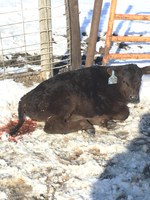Coccidiosis Affecting Young Calves
(Click the image below to view a high-resolution image that can be downloaded)
North Dakota cattle producers have been losing young calves to coccidiosis this spring, according to Gerald Stokka, North Dakota State University Extension veterinarian and livestock stewardship specialist.
Coccidiosis is an intestinal disease that affects several animal species. In cattle, it may produce clinical symptoms in animals 3 weeks to 1 year old, but it can infect all age groups.
Coccidia are a protozoan parasite that has the ability to multiply rapidly and cause clinical disease. They should not be confused with cryptosporidia, which also are a protozoan parasite affecting cattle but differ from coccidia species, Stokka says.
Cryptosporidia can be a cause of newborn calf diarrhea and often is a co-infection with bacterial or viral infections of the small intestine. Cryptosporidia infections can result in human infections, so people need to be very conscious of sanitation when dealing with scouring calves.
“Coccidia are very host-specific; that is, only cattle coccidia will cause disease in cattle,” Stokka says. “Other species-specific coccidia will not cause disease in cattle.”
Rapid multiplication of the parasite in the intestinal wall and the subsequent rupture of the cells in the intestinal lining cause the majority of the damage in calves with coccidiosis.
Several stages of multiplication occur before the final stage, the oocyst (egg), is passed in feces. Oocysts are extremely resistant to environmental stress and are difficult to remove from the environment completely. Oocysts must undergo a final process called sporulation before they are infective again.
Oocysts frequently contaminate feed and water. When other animals ingest the sporulated oocysts, the oocysts start their life cycle over in the new host.
Symptoms
In young (3- to 6-week-old), suckling calves, clinical signs of coccidiosis may develop following stressful events, such as weather changes, or if the calves are in unsanitary conditions.
“Symptoms or signs of coccidiosis will depend on the stage of the disease at the time of observation,” says Karl Hoppe, Extension area livestock systems specialist at NDSU’s Carrington Research Extension Center.
In general, coccidiosis affects the intestinal tract and creates symptoms associated with it. In mild cases, calves only have a watery diarrhea, but in most cases, blood is present in the feces. Straining, along with rapid dehydration, weight loss and anorexia (off feed), may be evident.
Animals that survive for 10 to 14 days may recover; however, permanent damage may occur. The lesions associated with coccidiosis that are found after death generally are confined to the cecum, colon, ileum and rectum.
A diagnosis should be based on laboratory findings and clinical signs because other infectious diseases such as salmonella and bovine viral diarrhea virus also may lead to blood in the stool, Stokka notes.
Animals’ susceptibility to coccidiosis varies.
“Coccidiosis frequently is referred to as an opportunist, which is a disease that will develop when other stress factors are present or in the young calves when exposure to the oocysts is overwhelming,” Stokka says.
“The life cycle of coccidiosis in calves is approximately 21 days,” he adds. “This means that if a 3-week-old calf is showing signs and symptoms of coccidiosis, the calf was exposed to the oocysts at birth. The logical conclusion to young calf coccidiosis is that calving grounds are highly contaminated.”
Treatment
Infected animals must be treated for the infection and to correct dehydration. Producers should select the proper drugs in consultation with their veterinarian. Sulfa drugs and a therapeutic dose of amprolium are available to treat coccidiosis. Antibiotics may be necessary if secondary bacterial infections are suspected.
Products also are available for treating the entire group of calves, but medicating all calves in beef herds is difficult, Stokka says.
Prevention
Treatment and prevention are most effective when started early, Stokka and Hoppe say. They suggest these steps to prevent coccidiosis:
- Move calving grounds to a clean area free of contamination.
- Increase the amount of space per cow during the calving season.
- Feed an additive that can reduce the presence of coccidia.
“Feeding a coccidiostat (decoquinate) or an ionophore (monensin or lasalocid) to the herd prior to and during calving may help,” Hoppe says. “Be sure to follow label claims because monensin and lasalocid have slightly different label claims.
“Feeding an ionophore to the cows for reducing the overall coccidia parasites present in the environment also has the benefit of improving feed efficiency,” he adds.
NDSU Agriculture Communication - April 3, 2019
| Source: | Karl Hoppe, 701-652-2951, karl.hoppe@ndsu.edu |
|---|---|
| Source: | Gerald Stokka, 701-231-5082, gerald.stokka@ndsu.edu |
| Editor: | Ellen Crawford, 701-231-5391, ellen.crawford@ndsu.edu |


